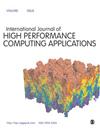Exascale models of stellar explosions: Quintessential multi-physics simulation
IF 2.5
3区 计算机科学
Q2 COMPUTER SCIENCE, HARDWARE & ARCHITECTURE
International Journal of High Performance Computing Applications
Pub Date : 2021-07-20
DOI:10.1177/10943420211027937
引用次数: 7
Abstract
The ExaStar project aims to deliver an efficient, versatile, and portable software ecosystem for multi-physics astrophysics simulations run on exascale machines. The code suite is a component-based multi-physics toolkit, built on the capabilities of current simulation codes (in particular Flash-X and Castro), and based on the massively parallel adaptive mesh refinement framework AMReX. It includes modules for hydrodynamics, advanced radiation transport, thermonuclear kinetics, and nuclear microphysics. The code will reach exascale efficiency by building upon current multi- and many-core packages integrated into an orchestration system that uses a combination of configuration tools, code translators, and a domain-specific asynchronous runtime to manage performance across a range of platform architectures. The target science includes multi-physics simulations of astrophysical explosions (such as supernovae and neutron star mergers) to understand the cosmic origin of the elements and the fundamental physics of matter and neutrinos under extreme conditions.百亿亿次恒星爆炸模型:典型的多物理场模拟
ExaStar项目旨在为在exascale机器上运行的多物理天体物理模拟提供一个高效、通用和便携的软件生态系统。该代码套件是一个基于组件的多物理工具包,建立在当前模拟代码(特别是Flash-X和Castro)的能力之上,并基于大规模并行自适应网格细化框架AMReX。它包括流体力学、先进辐射传输、热核动力学和核微物理学模块。通过构建集成到编排系统中的当前多核心包,该代码将达到exascale效率,该编排系统使用配置工具、代码转换器和特定领域异步运行时的组合来管理一系列平台架构的性能。目标科学包括对天体物理爆炸(如超新星和中子星合并)的多物理模拟,以了解元素的宇宙起源以及极端条件下物质和中微子的基本物理。
本文章由计算机程序翻译,如有差异,请以英文原文为准。
求助全文
约1分钟内获得全文
求助全文
来源期刊
CiteScore
6.10
自引率
6.50%
发文量
32
审稿时长
>12 weeks
期刊介绍:
With ever increasing pressure for health services in all countries to meet rising demands, improve their quality and efficiency, and to be more accountable; the need for rigorous research and policy analysis has never been greater. The Journal of Health Services Research & Policy presents the latest scientific research, insightful overviews and reflections on underlying issues, and innovative, thought provoking contributions from leading academics and policy-makers. It provides ideas and hope for solving dilemmas that confront all countries.

 求助内容:
求助内容: 应助结果提醒方式:
应助结果提醒方式:


